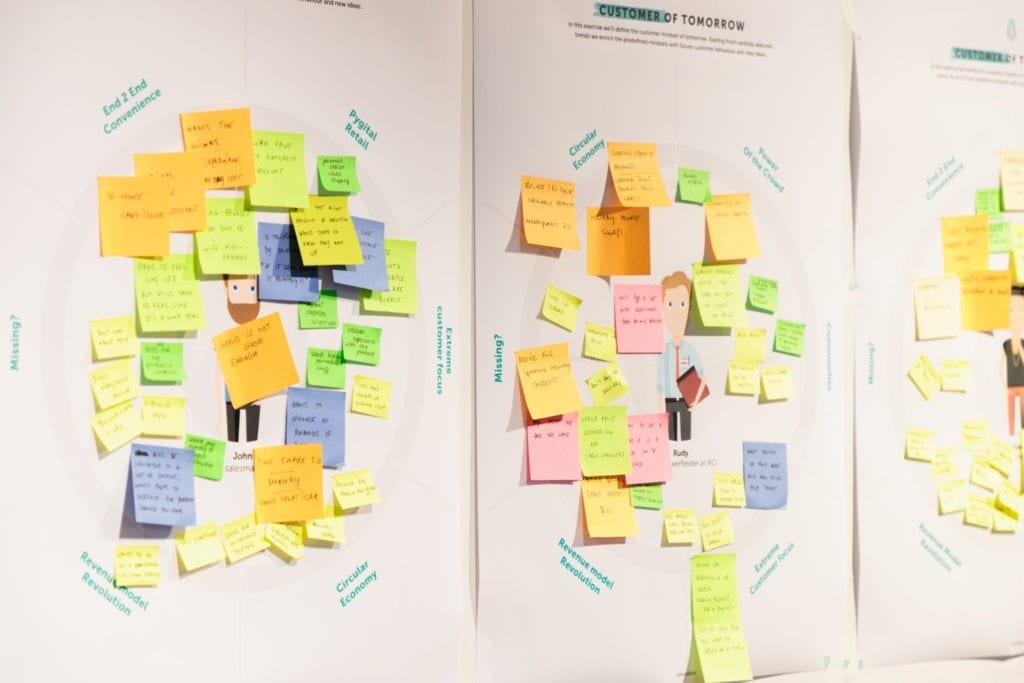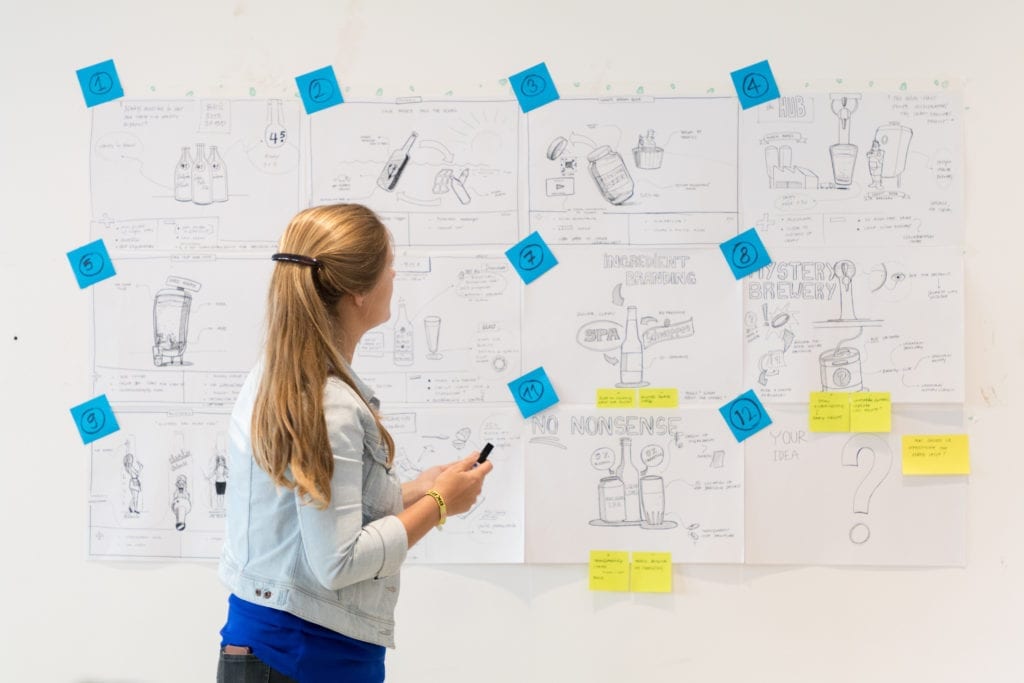Key takeaways
Have you ever been involved in building a corporate startup or new business? It’s no easy feat! It can take weeks to align schedules, brainstorm, create specs and finally get the green light to execute your ideas. Thank goodness for design sprints! A framework created to reduce risk, keep you agile and take you from “challenge” to “solution” in just a few steps…but it takes more than just a week…
In this article, we’ll explore the 5 stages of your sprint week as well as the essential steps you need to take before and after to ensure next-level success.
The truth is, design sprints aren’t magically going to solve whatever problem you’re looking to tackle. You’re still going to work hard, get stuck and look at a few bad ideas before finding the right one, but you’ll do it in a way that is quicker, leaner and way more effective.
So what are the steps? And why does it take longer than a week?
Well, because the 5 days most sources talk about will only cover your actual sprint week. But there’s a whole lot more happening before and after that takes about 4 to 6 weeks in total.
We’ve distilled the whole process into 5 steps:
- The Intake
- The Deep Dive
- The Sprint Week
- Idea Validation
- The Finish
Let’s examine them more closely, shall we?

The Intake
Align With Your Team
The intake is essential because it sets the tone of your whole sprint. It’s a time for you and your team to get on the same page in terms of goals and resources.
In the absence of an intake session, you run the risk of spending day 1 assessing your goals, rather than working towards reaching them. The last thing you want is to lose half a day trying to “figure things out”. It can actually block you from compiling the necessary information or expertise you need to reach your ultimate goal or target.
Be proactive instead and book a meeting with a few relevant profiles from your team before the actual sprint week. You’ll want to involve the facilitator, management profiles and any relevant experts on the topic of your sprint.
Intakes last about 4 hours and can save you a whole lot of time and effort in the long run, so don’t forget to schedule it before your sprint week.

The Deep Dive
Time to Fuel Your Sprint with Trends
Deep dives can take 1 to 2 weeks and they provide a space for preparation and learning.
It’s a time for you to become more informed about how others in your business approach similar challenges. It can also be useful to study the winning trends outside your industry because you never know where that next great idea will come from.
Deep dives don’t necessarily have to involve the whole team, just a few sprinters with relevant backgrounds will do.
The research itself can be as simple as a few hours of desk research or as complex as hiring an external agency to compile a report of findings for you. You can even do a bit of “deep heat detection”, which is when you reach out to customers and ask about the things that frustrate them about a particular product or service.
The results gathered during your deep dive are meant to fuel your sprint and provide inspiration during your brainstorming later on.

Zooming in on the Sprint Week
Day 1: Inspire
Day one is a stepping stone for the rest of your sprint. It’s when your first ideation exercises take place and you really align with the whole team in terms of goals, direction, and mindset.
Generally speaking, day 1 will be quite fun because it’s a time for pure creativity and the ideas are still unrestrained and out of the box.
Start things off by sharing some of your findings from the deep dive. The industry trends you found will serve as a “muse” to inspire the team, show them the direction you want to move in and help them come up with their own suggestions and feedback.
The second half of the day should be dedicated purely to brainstorming and ideation. The goal is to end up with around 50 ideas or concepts that will serve as the base for the work you will be doing in the days that follow.
Need some techniques to help energize your team? Click here for some expert tips on how to set the right mindset and give your design sprint an extra boost.
Day 2: Ideate
Day 2 is when the real ideation starts to happen. It has a more serious and focused tone to it because you’ll be sifting through the ideas from day 1 and refining them into concepts.
You can start day 2 with a brainstorming exercise aimed at taking you from 50+ ideas to 10 solid concepts. Simple tools like dot voting are perfect for getting the whole team involved and making sure everyone has a say. Learn more about dot voting.
Once you’ve narrowed things down, it’s time to move on to the development phase.
At this point, you’re still in the process of elimination so it’s a good idea to keep your tools basic. Use simple drawings and sketches for illustrations and basic value proposition canvases to keep your information visible and organized. Learn more about the value proposition canvas methodology.

Day 3: Decide
On day 3 you’re ready to choose your best concepts and eliminate all the rest (e.g. go from 10 good ones to 3 great ones). You’ll also be delving a bit deeper into your concept development.
Management profiles should be present for this phase because their feedback is vital to the voting process. They have the know-how you need to move forward and choose the types of solutions that would yield the most return.
Think about involving people that really understand your customer needs (e.g. industry experts, small groups of customers).
When presenting your concepts to management, make sure to include any relevant information they need to make educated decisions i.e. elaborated concept cards, revenue streams, key features, and any visuals that show what your solution might look like.
Day 4: Visualize
Day 4 is all about bringing your vision to life and making it as tangible as possible for the upcoming pitch.
If for example, you’ve ended up with 3 concepts, it means you need to get cracking on 3 different mock-ups or prototypes to present during the pitch. Screens and dashboards are a great way to convey relevant data in a way that is practical and visually appealing.
You might also want to think about dividing the group up into teams e.g. graphic designers on one team and numbers guys on the other. It’s a great way to let each person on your team shine, while at the same time ensuring that only their best work goes into the final presentation.

Day 5: The Pitch
Day 5 can be summed up in just one word: anticipation.
It’s the day you’re finally able to test out your concepts and find out which ideas worked, which didn’t and how to move forward from there.
During the pitch, you’ll be presenting your concepts and conclusions (i.e. mockups, prototypes, revenue streams, etc.) to the client. It’s your chance to gauge your client’s response and substantiate the work you’ve done so far.

Validation
Get Feedback from Potential Clients
The validation phase happens after your sprint week and takes about 1 to 2 weeks on average.
If you’re testing out more than one concept (e.g. 3 of them), it can be useful to give your client some additional time to mull things over and really think about the solutions you’ve come up with (instead of getting a “first impulse” response right after the presentation).
Feedback can be collected in intervals over the span of a few days or even a few weeks after the pitch.
Validation can be especially useful when you’re pitching a disruptive business idea because it provides your end-user with the time needed to do a test run and assess the effects of the changes. Extra time can also be useful when you need to pitch the idea to several departments within your client’s organization.

The Finish Line
Don’t let your Ideas Die
You’ve done all the work, presented the findings and gathered all the relevant feedback.
Now what?
Well, it’s going to depend on the outcome of your sprint, which could go 1 of 3 ways:
- You’ve got gold – Your disruptive idea is a total hit and you have a pretty clear idea of how to achieve your minimum viable product (MVP). Now it’s time to “tune” your idea like a grand piano before a concert at Carnegie Hall.
- Mixed results – You’re on the right track, but your concept still needs some tweaks and adjustments. Don’t fret, you’ve got a solid base from which to move forward. Start your next sprint on day 2: Ideate. You’ll tighten those loose ends in no time!
- Back to the drawing board – You’re not where you need to be, but you’ve crossed a few “no go” ideas off your list. It’s still progress! Start your next sprint on day 1 to kick start your creativity and explore new out-of-the-box ideas.
Looking for innovative ways to disrupt your industry and tackle new markets? Let’s talk!
We’ll help you take your innovation strategy to the next level.








